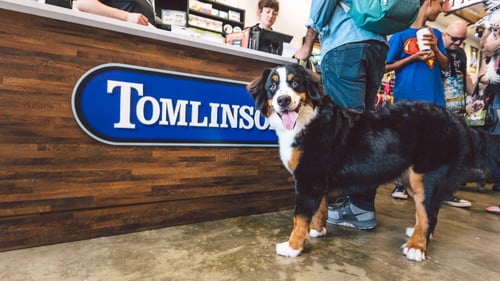Nov 4, 2022 4:19:24 PM
Training & learning | Retail
Nov 4, 2022 4:19:24 PM
Training & learning | Retail

Retail training for store associates is failing.
Sales associates are on the frontline of a retailer’s mission, interacting with customers every day, curating a brand experience, and physically making sales. For customers, they are the face of a brand. But still, 40% of frontline employees are trained only once a year or less.
“The only thing worse than training employees and losing them is to not train them and keep them” as Henry Ford, the founder of Ford Motor Company, allegedly said.
As with everything worthwhile in life, the only way to achieve retail success is to nurture and train for it.
This guide will explore why training matters in the retail industry, where retailers are going wrong and how training can be improved.
Retail sales training enables store employees to do their jobs to the expected standard. It equips retail employees with the skills and knowledge to serve customers and operate effectively as part of the store team.
Retail training includes:

Basic retail sales training enables store associates to do their jobs. Impactful retail training empowers store associates with the confidence and initiative to provide customers with an experience that will keep them coming back. Well-trained retail staff have the ability to provide service that’s attentive, efficient and delivers brand values and product knowledge with a personal, human touch.
Employee experience and customer experience go hand in hand, so investing in frontline employees is a sure-fire way to optimize the customer experience in-store.
49% of learners say that they don’t have time to learn at work. This is understandable, as in the hectic, fast-paced environment of a store, employees are pulled in all directions at once, serving customers, keeping the store clean and safe, and completing admin tasks. All too often, this means that employees need to find time to complete training outside of their working hours in order to progress.
Frontline retail workers typically juggle work with other responsibilities such as caring for a family, studying, and other jobs. A McKinsey report on Women in the Workplace found that full-time working mothers were spending about an additional 20 hours a week doing unpaid housework in addition to their paid jobs. When this is the case, employees don’t have time to spare outside of working hours doing training, so retail staff training becomes completely inaccessible for frontline employees in a busy retail environment.

Retail associate training typically begins with the onboarding process, but all too often employees receive a huge information dump at onboarding and then little training thereafter. Imagine if, after being selected for the national team, an Olympic athlete trained intensively for the first week and then only trained once a year thereafter. It would be disastrous.
For retail sales associates, this is also recipe for disaster when you look at the science. Ebbinghaus’ Forgetting Curve demonstrates that after an initial training session, 50% of knowledge is forgotten within a day, and 90% is forgotten after a week if no repetition of the information takes place. Therefore these infrequent information dumps are not only overwhelming for employees, but they are a complete waste of time in terms of actually retaining any information.
A survey of 1,000 frontline employees found that only 28% of millennials surveyed found it easy to understand whether their work meets company expectations. Frontline workers don’t know how they can reach their goals, or if they do, they don’t have the resources in place to start working towards them.
The link between training and progression is clear: 48% of frontline workers trained once a year or less report a lack of career progression compared to 32% of workers trained more than once a year. Failing to frame training within a clear pathway towards progression means that employees have no idea how to progress.
Leonardo Da Vinci famously claimed: “Study without desire spoils the memory, and it retains nothing that it takes in”. In short, if learners don’t want to learn, they won’t remember much. This is as true now as ever. But frontline employees, who are often younger members of society, do want to learn. In recent surveys, 65% of millennials said personal development was the most important part of their current job.
So why is it that 34% of millennial frontline employees report a lack of career growth? This is partly down to employers’ failure to provide frontline workers with recognition or external motivators for completing training. 50% of younger employees don’t feel that their management recognizes strong job performance and 67% aren’t satisfied with what their employer invests in rewards and recognition. If management doesn’t recognize the efforts employees put in- why would they be motivated to improve?
One in three employees claim that lack of interesting content is a barrier to their learning. This is unsurprising, as traditional training formats like lecture-style classroom learning and reading handbooks or instruction manuals doesn’t engage the learner. If learning doesn’t grab and hold employees’ attention, it’s unlikely that they’ll take much information in.

More mistakes
Ineffective training means that mistakes are more likely and tasks will take longer. Being tied up fixing mistakes or taking a long time to complete processes and procedures takes employees’ focus away from the customer.
Worse customer experience
When employees can’t give customers their full attention, are making mistakes and are demotivated in their roles, they won’t be able to provide customers with the experience they expect. Not investing in employee training will drive away customers in herds. Around 50% of customers will switch to a competitor after just one bad experience.
Higher turnover
Employees who don’t feel like they’re progressing won’t perform their best or feel fulfilled. Especially if they feel their stagnation is down to a lack of investment in their development from an employer. Unfulfilled workers will turnover faster and are unlikely to recommend the company as a place to work.
Frontline employees are always on their feet rushing between one task and the next. They need to be able to access training materials in a way that slots into this style of work, so mobile learning is the ideal solution.
By implementing a BYOD policy or providing sales associates with mobile devices, employers can enable sales associates to access learning on the store floor. This is essential for employees to be able to find information at their point of need without disrupting their flow of work by needing to run to a back office. When learning is easily accessible on the job, employees will be more motivated to learn as it fits easily into their work day.
Related: Why Frontline Employees Need to Learn in the Flow of Work
Retail sales training is a marathon, not a sprint. A huge influx of training at onboarding will do little to empower employees on the job. Instead, frequent, bitesize training that fits into the flow of work gives employees the tools they need on the job without overwhelming them and causing cognitive overload.
Also known as ‘microlearning’, this approach delivers training in to-the-point, self-contained modules that last no more than a few minutes. Consuming information in small chunks is more digestible and if employees are able to repeat modules when they may need a refresher it also cements information into store employees’ memory more firmly.
Related: A Guide to Microlearning: What It Is and Why Your Employees Need It
Make paths linking training to progression clearly visible. Employees need to be able to see exactly what training program they need to complete in order to see the results they want. Encourage employees to set personal progression goals or work with management to set them.
Goals could be company specific, like a promotion, or more general, like being mentioned in 5 positive customer reviews or completing advanced first aid skills training. Although some level of turnover is inevitable, all employees will likely have professional milestones they want to work towards and it’s great to know that their employer is invested in them.

Career progression is not the only way to motivate employees to complete training, all employees are unique, so they’re motivated by different things. Providing incentives for completing training can be as simple as recognizing teams who complete the most learning with a shout-out on the company communications channel.
Other effective incentives include offering financial bonuses, prizes, ‘learner of the month’ awards, or putting on events and team social activities. Learners who use social features in their training like forums, comments and Q&As complete 30 times the amount of training as those who don’t.
Learning needs to be an enjoyable social activity - 58% of frontline employees agree that the most important thing about learning is for it to be fun and engaging. This claim is backed by science, as information is more likely to be retained when the brain is experiencing strong positive emotions.
Gamification can deliver learning in a way that achieves this by encouraging healthy competition and collaboration with points, challenges and leaderboards. Review 42 discovered that learners who complete gamified training score 14% higher in skill-based assessments than those who complete regular training and only 28% of people feel motivated during non-gamified training. If training is to be worthwhile, gamification is essential.
Related: 5 Retail Training Best Practices for 2021 and Beyond
When rethinking retail training, it can be tough to know where to begin. A great place to start is following these steps:
Decide how to measure the success of training
Work out how you plan to measure how successful training will be. This will enable you to continuously improve training strategies by reflecting on what has been most effective.
Think about why you are revamping training? Where are the organizational weaknesses? Use this to determine what metrics to use to measure positive change.
Metrics to measure success could include the number of training courses completed, the average time it takes to complete tasks, the number of sales made, average basket size, or the percentage of positive customer reviews.
Talk to the store teams
Ask them what tools and processes they currently use for training, where they think they need more training, how they like to learn and what sort of incentives would motivate them to learn more. This will provide a picture of how training currently takes place in-store and where it needs improving.
Use this to inform and shape how you proceed with creating new learning content and roll it out across the retail store network.
Find the right tool
Look for a training platform that will enable employees to learn in a way that meets the needs of employees. In the retail business, this is typically a platform that is mobile-first, can push out a lot of training at scale and has gamified features.
A key differentiator for specialized pet food retailer Tomlinson’s Feed is having highly educated, expert employees. However, they had been delivering learning content via PDF attachments and on physical pieces of paper, which meant that employees couldn’t easily access information on the go.

As employees were used to using smartphones in their social lives, investing in app-based learning allowed employees to train in a familiar format that tapped into the competitive spirit of team members. Tomlinson’s ensured that there were lots of gamified training courses set up in the app prior to launch, so employees could dive straight in and get excited about learning.
According to Kate Knecht, Brand Director, “People ate up the training, and they were able to retake it if they felt they didn’t retain something, it’s there and it’s accessible for them to go back to and refer to”.
Tomlinson’s report that rolling out an engaging, mobile-first learning tool has significantly improved information retention in-store teams and has fuelled excitement around training, turning learning into a positive social experience.
Read more: Interview: How Tomlinson's Feed Empowers Their Store Teams
GANT were on the hunt for a new way to empower its store teams to be the best possible ambassadors of its brand. With 750 stores globally, 1600+ employees, and still rapidly expanding, GANT was looking for a way to ensure a consistently exceptional customer experience in every store.
By switching to an interactive mobile-first learning tool, GANT was able to provide continuous learning opportunities which fuelled employee engagement, leading to a 30% increase in training course completion.
Find out more about how they did it in this case study: How GANT connect their global community of store associates through better training and communication
To make a real impact on customer experience in 2021, retail sales training needs to be:
--
Over 200 retailers and brands use YOOBIC to equip their store teams with the skills and knowledge to provide a flawless customer experience, every time. To find out why, schedule your demo now.
Search the blog

See why 350+ businesses are using YOOBIC
YOOBIC creates a better everyday working experience for frontline teams while helping businesses drive performance at scale.
PRODUCT
See why 350+ businesses are using YOOBIC
YOOBIC creates a better everyday working experience for frontline teams while helping businesses drive performance at scale.